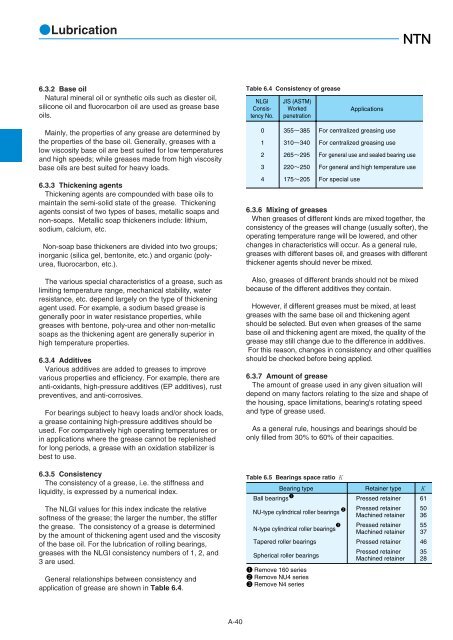NTN - Large Bearings
Create successful ePaper yourself
Turn your PDF publications into a flip-book with our unique Google optimized e-Paper software.
Lubrication<br />
6.3.2 Base oil<br />
Natural mineral oil or synthetic oils such as diester oil,<br />
silicone oil and fluorocarbon oil are used as grease base<br />
oils.<br />
Table 6.4 Consistency of grease<br />
NLGI<br />
Consistency<br />
No.<br />
JIS (ASTM)<br />
Worked<br />
penetration<br />
Applications<br />
Mainly, the properties of any grease are determined by<br />
the properties of the base oil. Generally, greases with a<br />
low viscosity base oil are best suited for low temperatures<br />
and high speeds; while greases made from high viscosity<br />
base oils are best suited for heavy loads.<br />
6.3.3 Thickening agents<br />
Thickening agents are compounded with base oils to<br />
maintain the semi-solid state of the grease. Thickening<br />
agents consist of two types of bases, metallic soaps and<br />
non-soaps. Metallic soap thickeners include: lithium,<br />
sodium, calcium, etc.<br />
Non-soap base thickeners are divided into two groups;<br />
inorganic (silica gel, bentonite, etc.) and organic (polyurea,<br />
fluorocarbon, etc.).<br />
The various special characteristics of a grease, such as<br />
limiting temperature range, mechanical stability, water<br />
resistance, etc. depend largely on the type of thickening<br />
agent used. For example, a sodium based grease is<br />
generally poor in water resistance properties, while<br />
greases with bentone, poly-urea and other non-metallic<br />
soaps as the thickening agent are generally superior in<br />
high temperature properties.<br />
6.3.4 Additives<br />
Various additives are added to greases to improve<br />
various properties and efficiency. For example, there are<br />
anti-oxidants, high-pressure additives (EP additives), rust<br />
preventives, and anti-corrosives.<br />
For bearings subject to heavy loads and/or shock loads,<br />
a grease containing high-pressure additives should be<br />
used. For comparatively high operating temperatures or<br />
in applications where the grease cannot be replenished<br />
for long periods, a grease with an oxidation stabilizer is<br />
best to use.<br />
6.3.5 Consistency<br />
The consistency of a grease, i.e. the stiffness and<br />
liquidity, is expressed by a numerical index.<br />
The NLGI values for this index indicate the relative<br />
softness of the grease; the larger the number, the stiffer<br />
the grease. The consistency of a grease is determined<br />
by the amount of thickening agent used and the viscosity<br />
of the base oil. For the lubrication of rolling bearings,<br />
greases with the NLGI consistency numbers of 1, 2, and<br />
3 are used.<br />
General relationships between consistency and<br />
application of grease are shown in Table 6.4.<br />
0<br />
1<br />
2<br />
3<br />
4<br />
355385<br />
310340<br />
265295<br />
220250<br />
6.3.6 Mixing of greases<br />
When greases of different kinds are mixed together, the<br />
consistency of the greases will change (usually softer), the<br />
operating temperature range will be lowered, and other<br />
changes in characteristics will occur. As a general rule,<br />
greases with different bases oil, and greases with different<br />
thickener agents should never be mixed.<br />
Also, greases of different brands should not be mixed<br />
because of the different additives they contain.<br />
However, if different greases must be mixed, at least<br />
greases with the same base oil and thickening agent<br />
should be selected. But even when greases of the same<br />
base oil and thickening agent are mixed, the quality of the<br />
grease may still change due to the difference in additives.<br />
For this reason, changes in consistency and other qualities<br />
should be checked before being applied.<br />
6.3.7 Amount of grease<br />
The amount of grease used in any given situation will<br />
depend on many factors relating to the size and shape of<br />
the housing, space limitations, bearing's rotating speed<br />
and type of grease used.<br />
As a general rule, housings and bearings should be<br />
only filled from 30% to 60% of their capacities.<br />
Table 6.5 <strong>Bearings</strong> space ratio K<br />
Bearing typeRetainer typeK<br />
1<br />
Ball bearings<br />
Pressed retainer 61<br />
<br />
<br />
NU-type cylindrical roller bearings<br />
2<br />
3<br />
<br />
N-type cylindrical roller bearings<br />
Tapered roller bearings <br />
Spherical roller bearings<br />
1 Remove 160 series<br />
2 Remove NU4 series<br />
3 Remove N4 series<br />
For centralized greasing use<br />
For centralized greasing use<br />
For general use and sealed bearing use<br />
For general and high temperature use<br />
175205 For special use<br />
Pressed retainer<br />
Machined retainer<br />
Pressed retainer<br />
Machined retainer<br />
Pressed retainer<br />
Pressed retainer<br />
Machined retainer<br />
50<br />
36<br />
55<br />
37<br />
46<br />
35<br />
28<br />
A-40

















